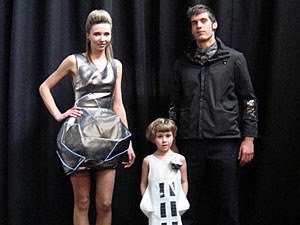The sunny side of engineering

Solar-energy projects shine at the 2011 undergraduate engineering showcase
As the University of Minnesota wrapped up the 2010-11 academic year, talented young engineers flocked to Coffman Memorial Union to display projects of all kinds, from an improved ankle prosthesis to an arm exerciser for stroke patients to a tracking system to test the skills of police dogs.
The projects at the Electrical and Computer Engineering and Mechanical Engineering Senior Design Show were too numerous to present in this space, so here are two that caught our eye—both solar energy-related projects—from some of our best and brightest students.
Photovoltaic clothing
Students from the College of Science and Engineering (CSE) and the College of Design (CDes) teamed up to create solar-powered clothes for the whole family. Each garment includes integrated solar panels that power electronics in the garment. The men's jacket and woman's dress light up, the dress carries a battery that can store energy, and the jacket can charge an iPhone. The little girl's dress has a beaded flower that spins when she squeezes a soft switch in her pocket.
"I never dreamed engineers working with fashion designers could have collaborated to create something so innovative," says team member and newly graduated engineer Karla Simonson.
The clothes were modeled at the Sol Inspiration Fashion Show, an exhibit of eco-themed garments in the Twin Cities.
Student team members included Akmal Arifin, Shan Seong Gan, Benjamin Lewiski, Yvonne Li, Allison R. Danzl, Silvia G. Guttmann, Sara E. Lopez Dziyana Zhyhar, and Karla Simonson. Faculty advisers: Rhonda Franklin, CSE, and Lucy Dunne, CDes.
Smart solar tracker
The sun is a ready source of energy, but it has the annoying habit of moving across the sky—and up and down, too—during the course of a day. A tracking device that follows its movements would sure come in handy.
To make that happen, a the team of engineering students began with a mount to hold solar panels, then added controls to track the sun's movements in all four directions. They also designed the controls to decide when the wind is too strong to operate safely, in which case they turn the panels face down, and to keep track of how much solar energy is captured. And the students did all that using minimal inputs of power and cash.
Student team members include Jesse Geske, Phillip Hoffman, Dongwon Lee, Tanvi Sikka, and Faez Yahya. Faculty adviser: Philip Cohen, CSE.
